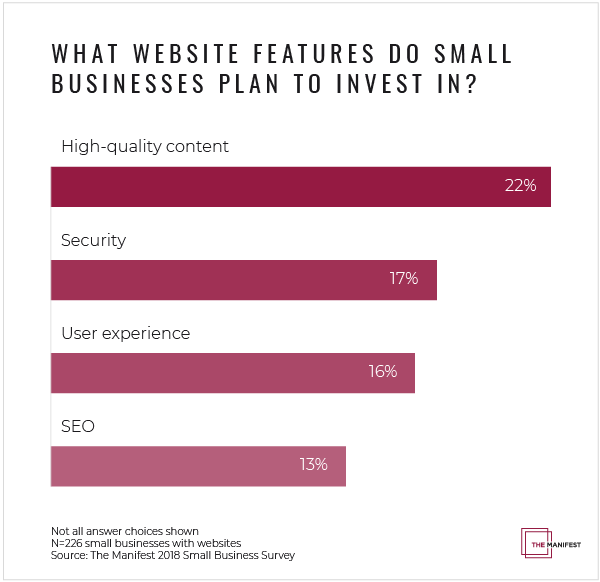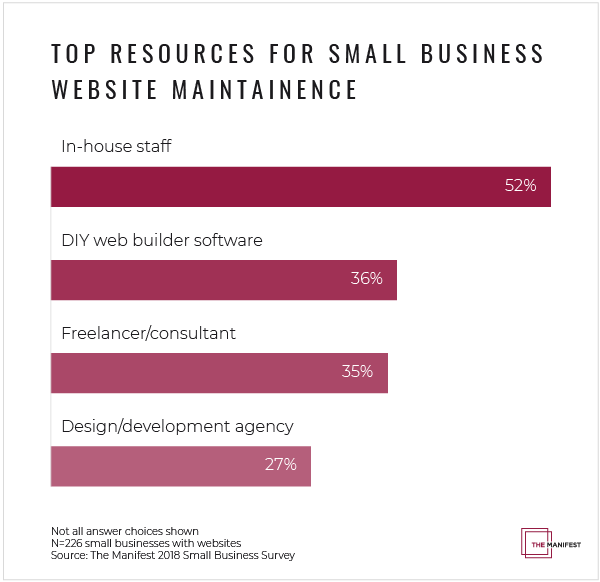How Small Businesses Invest in Website Maintenance

How Small Businesses Invest in Website Maintenance
As technology and website users’ expectations evolve, small businesses must keep pace by investing in website updates. Our 2018 Small Business Survey reveals that small businesses plan to maintain their websites by investing in high-quality content, increasing security, and improving user experience.
To reap the benefits of having a website, small businesses must adapt to changing trends and standards.
Nearly all small businesses with websites plan to invest in at least one website feature upgrade to keep pace with constant change.
We surveyed 351 small business owners to gain insight into how small businesses will invest in their websites in 2018.
In this article, we examine 5 key website features small businesses plan to upgrade and offer advice on how to approach website improvements.
Our Findings
- Nearly all (91%) small businesses plan to upgrade their website in some way.
- Small businesses’ top priority for websites in 2018 is to create more high-quality content; nearly a quarter (22%) plan to expand their content strategy.
- As security threats continue to grow, nearly 1 in 5 (17%) small businesses plan to improve their website security.
- Nearly 1 in 5 (16%) small businesses plan to invest in user experience to make their websites more user-friendly.
- Small businesses primarily rely on in-house staff (52%) and freelancers or consultants (35%) to build and maintain their websites.
- More than one-third (36%) of small businesses use DIY web builder software.
Virtually All Small Businesses Plan to Improve Their Websites in 2018
Small businesses already know that websites require regular updates. In fact, over 90% plan to invest in improving their websites in some way in 2018.

These investments fall into two main categories:
- Website content
- Website design
For nearly one quarter (22%) of small businesses, investing in website content is a top priority.

Small businesses also plan to invest in website design in the form of improved security (17%) and user experience (16%).
Collectively, these investments may also bolster search engine optimization (SEO) by strategically updating website text, calls to action, and information layout.
High-Quality Content Can Boost Search Engine Rankings
Small businesses report that their top priority for improving their websites in 2018 is creating more high-quality content. Nearly a quarter (22%) plan to expand their content strategy.

Website content has two key benefits:
- SEO
- Meaningful engagement with customers
To aid SEO, experts recommend that businesses regularly publish helpful content that strategically targets relevant keywords. When done well, strategic content marketing can increase a web page’s chance of appearing on the first page of search results.
Content can also drive customer engagement by educating and persuading customers to make a purchase, click on a link, or share their information, such as an email address.
For example, a small business might use its blog to build brand voice or give customers a glimpse behind the scenes, teaching them about the process used to create products while simultaneously demonstrating the products’ quality or originality.
Given these compelling benefits, it’s not surprising that creating high-quality content is a top priority.
A recent Hootsuite report outlined the key types of content small businesses rely on:
- Videos
- Blogging
- Case studies
- Longform content
- Whitepapers
- Ebooks
- Infographics
- Template and checklist downloads
Small businesses invest in this content to add keywords to their websites and create valuable resources that will naturally attract links over time.
Videos Engage Potential Customers and Drive Conversions
Among the content small businesses use to advance their SEO and brand building goals, video is emerging as one of the strongest contenders.
Cisco’s Visual Networking Index forecasts that video traffic will account for 82% of all internet traffic by 2021, compared to 73% in 2016. The Guardian has identified online videos as the future of content marketing.
Small businesses interested in investing in video should begin by identifying a clear goal and the resources they need.
Rachel Cevera is president of halfGenius, a Philadelphia-based creative agency with clients ranging from Verizon to Valentino. She believes that video content is effective because it provides transparency and authenticity.
“Thanks to the transparency provided by social media, gone are the days of the buyer beware 'Mad Men' era when brands could embellish any story to their benefit,” said Cevera.
Cevera points out that videos offer greater authenticity by providing a personal touch and the ability to see and react to another person’s facial expressions.
As video becomes an increasingly important website feature, many small businesses are already experimenting with adding different video content to their websites.
When Mark Aselstine founded Uncorked Ventures in 2010, creating an internet-based wine club still seemed like a “harebrained scheme,” he remembers.
Today, over 1,000 wine club members receive Aselstine’s handpicked bottles of wine, as well as stories of the winemakers who created them.
Last year, Aselstine struck up a conversation with a fellow parent at his son’s elementary school. By chance, the other parent mentioned that he was a professional videographer who profiled small businesses, and the two agreed to collaborate.
After posting the video, Aselstine monitored his website’s analytics to track the video’s effect.
“It was shocking,” said Aselstine. “In reality, it’s tripled conversions rates. Half of the people who watch the entire 2-minute video order something.”
It’s tripled conversions rates. Half of the people who watch the entire 2-minute video order something.
Even more promising, the majority of the conversions came from new customers.
In the future, Aselstine plans to make additional investments in unboxing and introduction videos.
Improved Website Security Serves as Insurance Against Threats
Second only to content marketing, website security is on small businesses' minds. Nearly 1 in 5 (17%) report that they plan to improve their website security in 2018.

Learn 7 ways to enhance your business website's security.
The MIT Technology Review warns that 2018 will bring data breaches, ransomware in the cloud, and attacks targeting artificial intelligence.
Bob Bentz is the president of Advanced Telecom Services, an international provider of telephony services, and Purplegator, a mobile-first digital agency. In the 29 years that he has been in business, Bentz had more than one brush with hackers.
“Many years ago, we got hacked from Russia,” recalled Bentz. The hackers began bombarding his customers with spammy text messages. In addition to angering customers, the hack put his company at risk of violating the Telephone Consumer Protection Act.
The hack affected Bentz’s company in two key ways:
- Reputation damage
- Financial harm
Reflecting on these experiences, Bentz suggested that small business owners think of website security investments as an insurance policy.
“We pay month after month for car insurance, and it makes us angry when we pay it because we think of ourselves as safe drivers,” said Bentz. “Well, eventually we all get in accidents, and then you’re glad you have it.”
Because hackers are continuously discovering ways to exploit websites’ gaps in security, small businesses need to be proactive about investing in stronger security measures to keep pace with evolving threats.
Small Businesses Must Obtain an HTTPS Certificate
Moving forward, small businesses will find that it’s mandatory to obtain an HTTPS certificate.
In 2014, Google rolled out plans to encourage websites to transition to HTTPS, or “Hyper Text Transfer Protocol Secure.” The certificate uses encryption to verify that the connection between your browser and a website is secure.
You can determine whether your website has an HTTPS certificate by checking the URL structure your website uses.
In practice, HTTPS certificates ensure that websites are authentic and trustworthy. They protect against hackers who try to redirect users to fraudulent websites to steal personal or financial information.
In 2016, Google announced that websites lacking an HTTPS certificate would be flagged as untrustworthy, and Google Chrome users would be warned not to trust those websites.
“Those risk screens are pretty scary,” said Bentz.
Knowing that nearly 60% of internet users rely on Chrome, Bentz worked with an agency to upgrade Advanced Telecom Services and Purple Gator to HTTPS.
“For the small amount that you would be charged to fix something like that, it wouldn’t make sense for [small business owners] to figure it out on their own,” said Bentz.
As Google puts pressure on small businesses to adopt HTTPS certificates, those who do not may begin to experience lower traffic.
Updated Web Design Offers Better User Experience, More Conversions
User experience research can help businesses understand how customers navigate websites – and ultimately convert into newsletter subscribers, shoppers, and loyal customers.
For nearly 1 in 5 (16%) small businesses, upgrading user experience is a top priority.
In his role as co-founder and chief experience officer at Seattle-based UX agency Blink, Kelly Franznick has noticed that as slick websites become more attainable, customers’ expectations are on the rise.
“Consumers are smart now,” said Franznick. “They’ve been through systems that have great experiences, and they know that it doesn’t have to be hard. They want that everywhere now.”
As small businesses invest in improving their website's user experience, it’s important to keep their customers’ specific needs in mind.
Gregory Bullock works at an e-commerce business called TheraSpecs, which provides tinted glasses for people who suffer from light sensitivity due to conditions such as migraines, traumatic brain injuries, or concussions.
While implementing a new website design with better user experience, Bullock prioritized changing elements that could trigger a user’s light sensitivity condition.
“Just being in front of a computer screen or being on their phone is something that could trigger their condition,” said Bullock. “The last thing we want is for our website not to abide by the recommendations that we would tell other people.”
For example, TheraSpecs' old website featured a picture slideshow. Some images had high contrast text.

Now, TheraSpecs avoids flashing images and stark contrast between colors.
While traditional user experience best practices would recommend changing the color of a button when a user hovers their cursor over it, TheraSpecs ensures that these color changes are subtle to avoid triggering a user’s condition.

“We still get some of the e-commerce benefits but not so dramatic that it could put somebody in pain,” said Bullock.
TheraSpecs’ story drives home the reason small businesses should test user experience best practices with their specific audiences.
Bullock encourages other small businesses to be patient and selective when testing changes to their websites.
“With everything we could be testing, it can overwhelm you pretty quickly,” said Bullock.
Initially, he anticipated collecting data on one particular change for four weeks. But it wasn’t until the text had run for eight weeks that a conclusive pattern emerged.
After overhauling TheraSpecs’ design in 2017 with particular attention to user experience, Bullock watched sales climb.
“Seeing the conversion rate go up was rewarding for us,” said Bullock. “It meant that that work was starting to pay off.”
Moving forward, he plans to focus on examining common paths customers take while they browse TheraSpecs’ website to pinpoint opportunities to place calls to action that can drive conversions.
Although small businesses can draw inspiration from tried-and-true user experience principles, it’s still important to test changes with their specific audiences.
Small Businesses Rely on In-House Staff and DIY Website Builder Software
As small businesses evaluate the resources they can draw on for website maintenance and upgrades, many assume hiring an agency is too expensive.
We found that small businesses primarily rely on in-house staff (52%) and freelancers or consultants (35%) to build and maintain their websites.

With this in mind, it’s not surprising to find that more than one-third (36%) of small businesses use DIY website builder software.
DIY website builder software simplifies website maintenance by providing:
- Automatic security updates
- Customizable designs that do not require coding or technical knowledge
- Modern website features such as a variety of payment options or on-trend navigation menus
These benefits make website maintenance more manageable for small, in-house teams.
Franznick finds that DIY website builder software is sufficient for many small businesses looking to deliver a relatively frictionless, modern website experience to customers.
“In many cases [DIY website builder software] gets you maybe 80% or 90% of the way there,” he estimates.
The final step is to customize the premade website template, tailoring it to a small business’ branding. For this, small businesses may require some assistance.
“Hiring a talented freelancer can be a good solution for a small business,” said Franznick.
Hiring a talented freelancer can be a good solution for a small business.
By relying on a combination of DIY website builder software and short-term help, small businesses can achieve a modern website at a fraction of the cost, compared to building a custom website through a development agency.
Jeff Moriarty is the digital marketing manager for Best Price Nutrition, a vitamin and supplement company that has served customers since 2002. Having grown to five retail stores and an e-commerce business, Best Price Nutrition is currently in the process of upgrading its website.
As Moriarty evaluated options for building a new website, he sought a platform capable of providing the much-needed reliability Best Price Nutrition’s previous website lacked.
“Every time there were updates, things would break,” said Moriarty. “It became very expensive to deal with.”
Speed and cost savings also emerged as top priorities, but changing Best Price Nutrition’s website still presented risks.
“Next to changing a domain name, moving platforms is the scariest thing you can do,” said Moriarty.
With over 5,000 products and countless links that would need to be redirected to the new website, Moriarty hired a third-party to migrate Best Price Nutrition to a new platform, which was created with website builder software.
Moving forward, Best Price Nutrition’s old website will be redirected to the newly upgraded version built using e-commerce web builder software. Their small staff will be able to rely on the new website to provide better security and easier maintenance in the long run.
Overall, small businesses can maximize their resources by relying on a combination of in-house staff, DIY website builder software, and freelancers or consultants for short-term help.
Website Maintenance Requires Strategic Investment
As small business owners grow their companies in 2018, website maintenance should be an essential component of their planning.
To improve SEO and engage customers, small businesses should invest in high-quality content, including video content.
As cybersecurity threats grow, small businesses should strengthen their website security to guard against potentially costly attacks. Some security measures, such as obtaining an HTTPS certificate, are all but compulsory due to requirements from popular web browsers.
Finally, small businesses must invest in improved user experience to increase conversion rates. By testing changes with their audiences, small businesses can learn how to answer customers’ needs and preferences.
To accomplish these website upgrades, small businesses primarily rely on a combination of in-house staff and DIY website builder software. At times, hiring short-term freelancers or consultants may help small businesses achieve these goals.
Website standards and consumer expectations are continuously changing, but yearly investment in website updates can help small businesses keep pace.
About the Survey
The Manifest surveyed 351 small business owners based in the United States.
The small businesses surveyed have between 1 and 500 employees, with 55% indicating that they have 10 or fewer employees. More than half (57%) reported annual revenue of less than $1 million.
